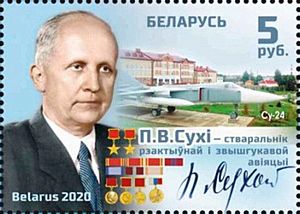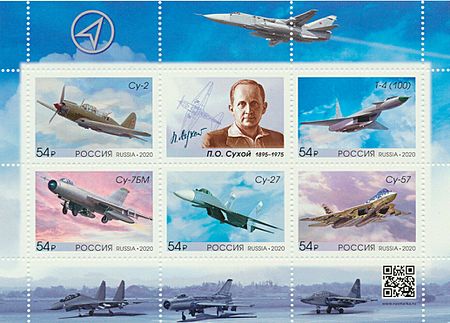Pavel Sukhoi facts for kids
Quick facts for kids
Pavel Osipovich Sukhoi
|
|
|---|---|

Sukhoi on a 2020 stamp of Belarus
|
|
| Born | 2 July 1895 Hlybokaye, Vilna Governorate, Russian Empire
|
| Died | 15 September 1975 (aged 80) |
| Nationality | Russia/Belarusian Soviet Union (after 1922) |
| Occupation | Engineer |
| Engineering career | |
| Discipline | Aeronautical Engineering |
| Employer(s) | Sukhoi Design Bureau |
Pavel Osipovich Sukhoi (Russian: Па́вел О́сипович Сухо́й; Belarusian: Па́вел Во́сіпавіч Сухі́, Paviel Vosipavič Suchi; 2 July 1895 – 15 September 1975) was a famous Soviet aircraft designer. He was an aerospace engineer who founded the Sukhoi Design Bureau. This company became well-known for making military aircraft.
Pavel Sukhoi designed planes for 50 years. Some of his most famous planes include the Sukhoi Su-7, Su-17, and Su-24. His aircraft even set world records! They achieved two altitude records (in 1959 and 1962) and two speed records (in 1960 and 1962). For his amazing work, Sukhoi was honored with the title Hero of Socialist Labor and received the Order of Lenin three times.
Contents
Pavel Sukhoi's Early Life and Education
Pavel Osipovich Sukhoi was born on July 22, 1895. His birthplace was Hlybokaye, which was part of the Russian Empire at the time. His parents were Belarusian farmers. Pavel had five sisters, but no brothers.
In 1900, his family moved to Gomel. His father, Osip Andreevich Sukhoi, became a teacher there. He taught at a school for children of railway workers. Pavel went to the gymnasium in Gomel from 1905 to 1914. This school is now known as the Belarusian State University of Transport.
In 1915, Pavel was accepted into the Imperial Moscow Technical School in Moscow. However, his studies were stopped. This happened because World War I had started, and he was called to join the Imperial Russian Army.
How World War I Affected Sukhoi's Life
Pavel Sukhoi became a warrant officer in the artillery. He served on the Russian Western Front. The Russian Army fell apart after the October Revolution in 1917. Pavel returned to Moscow, but his university was closed.
He went back to Gomel to live with his parents. He was offered a job as a math teacher in Luninets. This small town was near Brest-Litovsk. In 1919, Pavel had to leave Luninets. Polish troops were moving into the area during the Polish–Soviet War.
He returned to Gomel and started teaching at the railway workers' school. This was the same school his father led. Around this time, Pavel got very sick. He caught typhus and then scarlet fever. These illnesses affected his ability to speak clearly. Because of this, he became known as a quiet person for the rest of his life.
Returning to Studies and Starting His Career
In 1920, Pavel Sukhoi was finally released from the army due to his health. The government of the Russian Soviet Republic decided to reopen universities. Pavel went back to his studies at BMSTU. He graduated in 1925. His final project was about a "Single-engined Pursuit Aircraft of 300 hp." His teacher was Andrei Tupolev, a pioneer in aeronautics.
In March 1925, Pavel started working as an engineer and designer. He joined the Central Aerohydrodynamic Institute (TsAGI) in Moscow. He worked under Tupolev. Over the next few years, Sukhoi helped design and build important aircraft. These included the record-setting Tupolev ANT-25 and the large bombers, the TB-1 and TB-3.
In 1932, Sukhoi became the head of TsAGI's engineering and design department. By 1938, he was promoted to head of the design department. He also created a versatile light aircraft called the Su-2. This plane was used in the early years of World War II on the Eastern Front.
Founding the Sukhoi Design Bureau
In September 1939, Pavel Sukhoi started his own independent design company. It was called the Sukhoi Design Bureau (OKB Sukhoi). It was first located in Kharkiv. Sukhoi felt this location was too far from Moscow's scientific centers. He wanted his company to be closer to an aerodrome in Moscow Oblast. By mid-1940, the move was complete.
By the winter of 1942, Sukhoi faced a new challenge. He didn't have his own production line for planes. This meant he had less work to do. He had designed a new ground-attack aircraft, the Su-6. However, Soviet leader Joseph Stalin decided not to produce it. Stalin preferred another plane, the Ilyushin Il-2.
Sukhoi's Work in the Jet Age
After World War II, Sukhoi was one of the first Soviet designers to work on jet aircraft. He created several experimental jet fighters. In 1949, he lost favor with Stalin. He was forced to work under Tupolev again, as his Deputy Chief Designer.
In 1953, the year Stalin died, Sukhoi was allowed to restart his own Sukhoi Design Bureau. During the Cold War, Sukhoi designed many important combat aircraft. These included the supersonic Su-7, which became a main Soviet fighter-bomber in the 1960s. He also designed interceptors like the Su-9 and Su-15. These planes were very important for Soviet air defense.
Sukhoi also pioneered planes with variable-sweep wings. This means the wings could change their angle during flight. Examples include the Su-17 and Su-24. He also started projects that were never fully built, like the very fast Mach-3-capable Sukhoi T-3 attack aircraft. From 1958 to 1974, Sukhoi served as a deputy in the Supreme Soviet of the USSR.
Pavel Sukhoi passed away on September 15, 1975, in Moscow. He was buried in the Novodevichy Cemetery. The last fighter he designed was the T-10 (Su-27). Sadly, he did not live to see it fly.
Awards and Honors for Pavel Sukhoi
Pavel Sukhoi received many important awards for his contributions to aviation:
- Hero of Socialist Labor (1957, 1965)
- Lenin Prize (1968)
- Stalin Prize, first class (1943)—for creating the Su-6
- USSR State Prize (1975—awarded after his death)
- Three Orders of Lenin (1945, 1957, 1975)
- Order of the October Revolution
- Order of the Badge of Honour (1936)
- Order of the Red Banner of Labour (1938)
- Order of the Red Star (1933)
- Tupolev Gold Medal—For outstanding work in aeronautical science and engineering (1975)
See also
 In Spanish: Pável Sujói para niños
In Spanish: Pável Sujói para niños


